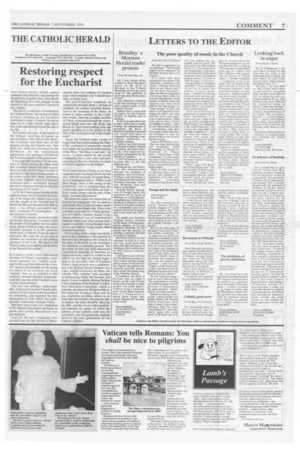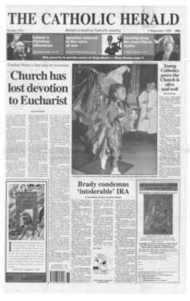Page 7, 3rd September 1999
Page 7

Report an error
Noticed an error on this page?If you've noticed an error in this article please click here to report it.
Tags
Share
Related articles
Benedict Xvi's Mission To Restore
The Redeemer Of Man
'i Wish To Rekindle Eucharistic Amazement By This...
Diminishing Sacrament
Pope And Patriarch Herald New Bond
Restoring respect for the Eucharist
TWO PUBLICATIONS, which appear (perhaps coincidentally, and perhaps by design) close together, may well indicate the beginning of a new chapter in the history of the post-conciliar Church in this country.
The first is a collection of meditations by Cardinal Hume, one section of which contains thoughts on the Eucharist (published in today's Catholic Herald on page 4) of a kind which many knew him to be entertaining towards the end of his life.
In October last year , at the launch of the bishops' teaching document on the Eucharist, One Bread One Body, the Cardinal said that one of the dangers facing the Church was "that there isn't sufficient reverence for the Eucharist. As the millennium approaches, the presence of Christ in the Eucharist needs to be underlined".
It was not only reverence for the presence of Christ during the Mass itself that Cardinal Hume felt had waned: there had also, he felt, been a decline in devotion for the reserved Sacrament: as he writes in his final book, published next week, "Outside Mass that presence continues and is celebrated through devotion and prayer before the Blessed Sacrament of the Altar".
As Fr Kit Cunningham recalls on the opposite page, his first action on learning of his inoperable cancer was to go into the chapel of the hospital and sit before the Blessed Sacrament for half an hour — "an obvious and natural reaction", comments Fr Cunningham, " to the sentence of death".
"A Catholic church", wrote the Cardinal shortly afterwards, "is a place where the people of God gather, but it is also a place where Christ is truly and sacramentally present. It is this presence which gives a Catholic Church its special character. We must do all we can to enhance our awareness of this abiding presence of our Lord. We need in the Church today to recapture our devotion to the Blessed Sacrament".
IN CARDINAL HUME'S VIEW, this kind of devotion to Christ's continuing sacramental presence was "slightly weakened in the years that followed the Council": and we will probably not be saying too much if we interpret the word "slightly" here as an example of that tendency towards English understatement that was one of the Cardinal's most lovable characteristics.
The loss was, perhaps, understandable, as the post-Conciliar Church rediscovered the Eucharist as the Sacrament of community, and explored the new dimensions of faith which that indispensable rediscovery brought with it.
But there were losses, too. Adoration of the Blessed Sacramant declined; in parish after parish, Benediction was discontinued.
And yet, the new vernacular rites included one for the service of Bene diction: there was nothing in Conciliar logic ivhich explains why it should have been so rarely used.
The post-Conciliar emphasis on community brought about a decline of emphasis on another essential dimension in the meaning of the Mass: its power to make present, in the Cardinal's words, "that one complete sacrifice of Christ, re-enacted through the consecrated bread and wine, the Body and Blood of Christ transcending time and space, enabling us to be present at the foot of the cross and close to the empty tomb".
Again, the Cardinal made a point of suggesting that understanding the Mass as the sacrament of community should not impede our sacrificial understanding of the Mass: "the Mass is not only", he wrote, "a meal shared by the parish community, but is also, and especially (our italics), the way whereby we share in Christ's sacrifice to his Father".
WHAT WENT WRONG? Partly, as we have suggested, new teachings drove out old ones: now it is necessary to restore them. As Fr Cunningham puts it "Often, in all these things, there is the swing of the pendulum, and in emphasising the community aspect of the Mass, its sacrificial nature, along with the role of the priest, has been diminished."
We must not waste too much time in looking for scapegoats: but we need to understand what, in practical terms needs to be done to put things right It has to be said that a large part of a whole generation of Catholic children, thanks to the almost universal use of catechetical materials which were either grossly inadequate or actually wrong-headed, have grown up without being taught these essential doctrines.
The teaching of the young was clearly seen by the Cardinal as a first priority in that recovery throughout the Church of the kind of devotion to the Eucharist for which he so earnestly prayed. The provision of rich and well articulated catechetical materials is therefore an urgent necessity: and it is a relief to be able to say that they are already beginning to be provided. One of Cardinal Hume's final projects was a collaboration with Bishop Vincent Nichols on a video, entitled Exploring the Mass, for schools. This, together with excellent accompanying books for teachers and pupils, is now available. Bishop Nichols is now chairman of the Bishops' Conference Education Committee, which is currently devising new Religious Education materials to replace those now in use. Exploring the Mass allows us to hope that our schools will soon be able to replace the truly dreadful Weaving the Web and Here I am with catechetical materials by means of which the fullness of the Catholic faith may be accurately and imaginatively handed down to the next generation of our Catholic children.
blog comments powered by Disqus













